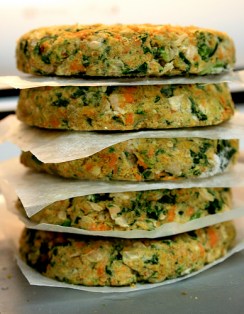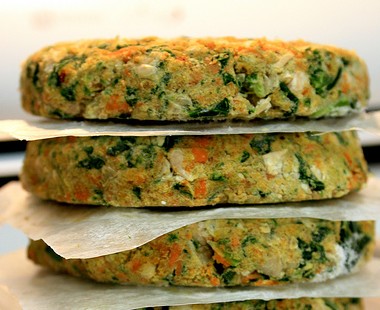This post is part of Protein Angst, a series on the environmental and nutritional complexities of high-protein foods. Our goal is to publish a range of perspectives on these very heated topics. Add your feedback and story suggestions here.

One way to make sure your veggie burgers are made with sustainable ingredients is to make them yourself. (Photo by Marni Molina.)
Like bikes, Birkenstocks, and buying local, soy products are a standard part of today’s stereotypical green lifestyle. But as many in the sustainable food world already know, we should proceed with caution when it comes to consuming processed soy products, as some are much more complicated than they seem.
To start with, it is much harder to find an organic soybean than, say, an organic carrot – only 0.2 percent of the soybean acreage in the U.S. is used to grow organic beans (compared with 13 percent of the carrot acreage). After corn, soy is the second-most-planted field crop in the U.S., and 92 percent of U.S. soybeans are genetically engineered to either withstand large amounts of pesticide or to produce it themselves.
“If you’re buying a non-organic soy product, I can pretty confidently say that [it] will have been grown on a large-scale monoculture farm,” said Charlotte Vallaeys of the Cornucopia Institute, which put out a report [PDF] in 2009 on the social, environmental, and health impacts of soy. “This is something people need to think about when they talk about soy as a good alternative protein source — that soy has to be grown somewhere; something has to fertilize the soil.”
Many vegetarians turn to soy as a meat substitute, but the soy industry is inextricably linked to meat. Some 80 percent of the conventional soybeans grown in this country end up on factory farms as livestock feed. And while meat-based diets have about twice the environmental impact of soy-based diets, a non-soy veggie diet beats them both.
So unless eaters choose exclusively organic soy, it’s not at all clear that what they’re eating it sustainable — or healthful.
The Cornucopia Institute’s soybean study reported that 37 percent of Americans seek out soy products for health reasons. While organic, whole soy products like milk and tofu offer a rich source of protein, the soy derivatives used in a multitude of products marketed as health foods — like energy bars and veggie Burgers — may carry their own negative health implications.
Minh Tsai, owner of an organic soybean company called the Hodo Soy Beanery in Oakland, Calif., explains that tofu and other soy products first took off in the Western world in the ‘60s and ‘70s, branded from the beginning as “fringe or hippie food.” As vegetarian diets grew in popularity — concurrent with the commercialization of organic farming — Big Food found ways to co-opt and mass-market soy, using a synthetic solvent called hexane to extract soy protein isolates from the bean. These isolates give veggie burgers and energy bars a cheap dose of protein.
“Tofu is a whole food,” Tsai said. “[Soy protein isolates are] kind of like [if] you get kale and you just extract one element of it and call it kale food. I liken it to drinking Tang versus squeezing your own oranges.”
The Cornucopia report looked at the environmental and health effects of using hexane in soy processing, a practice Steve Demos, founder of White Wave Foods, called “the dirty little secret of the natural-foods business.”
“Hexane is a neurotoxin, according to the CDC and the EPA, and that’s something that nobody will dispute,” Vallaeys said. “What they will dispute is how much the residues harm people. There really have not been any long-term studies on what the effects are.”
The EPA lists hexane — a petroleum byproduct of gasoline refining — as a hazardous air pollutant. In 2003, two workers in an Iowa soybean processing plant died when hexane gas at the plant ignited, and hexane has been linked to other fatal explosions in the U.S. and abroad. Workers exposed to large amounts of hexane over long periods of time have also shown nerve damage. But while hexane’s effects on workers have been examined, the toxin hasn’t been tested for its impacts on consumers who eat products that may be tainted with hexane residue — like protein bars and infant formula.
USDA organic standards specifically prohibit the use of hexane, so certified-organic soy products should be risk-free. But, as Vallaeys explained, a “second tier” of organic standards allows products with at least 70 percent organic components to claim to be “made with organic ingredients.” So, while Clif Bar can drive sales by declaring its products are “made with organic oats and soybeans,” it can still get away with using hexane-extracted soy protein isolates in the remaining 30 percent of its ingredients that don’t have to conform to organic standards.
“It’s not only confusing, but intentionally misleading customers,” Vallaeys said.
The Cornucopia report also included research indicating that soy in and of itself may have other harmful health effects that directly defy its FDA-approved “heart healthy” claim. Soy increases estrogen levels, which in turn increases risk of breast cancer and other estrogen-sensitive cancers. Soy infant formula carries special risk: Studies found soy-fed infants with estrogen levels 17,000 times higher than those fed with human or cow’s milk. Soy consumption can lead to reduced virility in men, and unfermented soy products (like tofu, milk, and yogurt) contain phytic acid, which blocks mineral absorption.
Keeping the amount of soy one consumes to a moderate level can help lower many of these risks. And when it comes to avoiding hexane residue, the moral of the story is — as always — to stay informed, read ingredients lists, and don’t assume that “made with organic something-or-other” is the same as full certification.
Tsai, for his part, thinks Americans got their approach to soy wrong from the beginning. He thinks whole soy foods — like tofu, his specialty — are underappreciated. “Tofu … was introduced first and foremost as a protein substitute. That was the first mistake,” he said. “It is a vegetarian food, but it was introduced not as a delicious food.”
By manipulating soy into various sad imitations of real meat, or bathing it in hexane in order to add protein to fancy processed creations, Tsai argues, we’re missing the soybean’s value as a food in its own right.
“Tofu tastes great,” Tsai said. “Sure, it’s healthy, yes, it’s environmentally friendly, but it’s got to taste good. Everything else is icing on the cake.”



